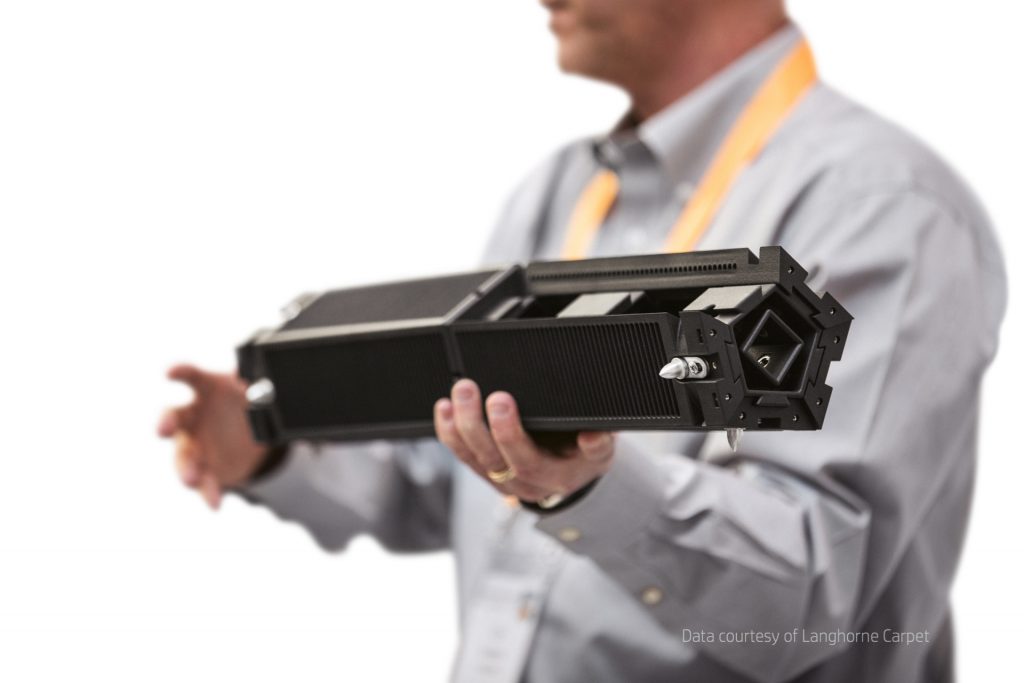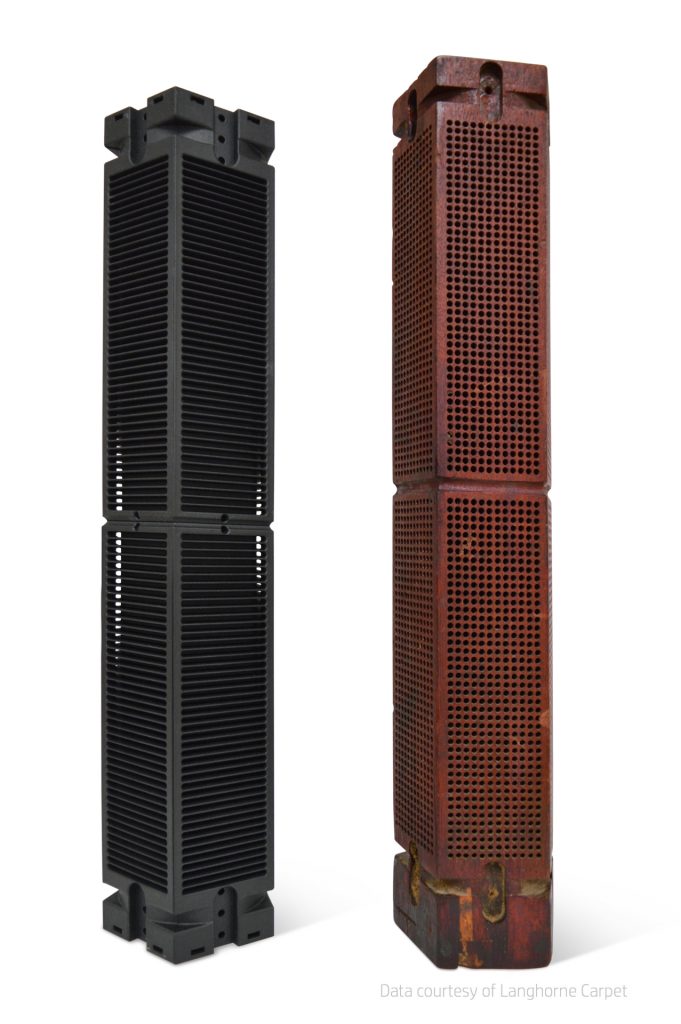ProtoCAM is a Pennsylvania based 3D printing service bureau that serves the defense, manufacturing and consumer goods industries. The firm works with stereolithography, selective laser sintering (Laser Powder Bed Fusion), HP MFJ and FDM. Starting out in prototypes the company is increasingly making production-ready parts in polymers. They came to us with an interesting business case for the Langhorn Carpets Company. This application was an AMUG Technical Competition winner for the Advanced Concepts category. Langhorn Carpets was founded in the 1930’s and has been producing carpets since then in Pennsylvania. The firm made a good capital investment in the 1930’s by buying carpet looms that they still use today. The problem? Spare parts were unavailable for these machines. The ProtoCAM team designed and produced a modular five-part assembly spare part on the Multi Jet Fusion machines. Replacement and spare parts are a great 3D printing business case especially for old machines for which there is no alternative parts supply. We expect there to be many more cases in industry where trusty old machines work but lack essential parts. Previously we covered this story but we interviewed Bob Holbrook the VP Sales and Marketing for ProtoCAM to find out more.

What types of parts were made?
Langhorne Carpets Company initially approached our team to 3D print an integral part for one of its 20th-century looms, the Jacquard cylinder. The part is a five-sided ‘master cylinder’ that operates at the heart of the carpet-weaving process.
Due to the extremely rare and environmentally sensitive nature of the original material, African hardwood, Langhorne would have traditionally had limited replacement options for this essential piece of the loom. Without 3D printing, the company would have had to purchase a new cylinder via custom order or seek out a refurbished one in excellent condition. Either option would typically cost the company an exorbitant amount of time and money.
Leveraging HP Multi Jet Fusion 3D printing technology, we were able to not only restore Langhorne’s loom, but create a replacement part that was more efficient and cost effective to produce.
What functionality did they have to have?
The cylinder is integral to the carpet-weaving process—decks of connected Jacquard punch cards, which determine the intricate designs and patterns of the carpet, feed into the cylinders and help produce the final product.
The 3D printed part needed to mirror the original size and five-sided cylindrical design while also maintaining the ability to reach the Jacquard punch cards. Because Langhorne’s looms are continuously operating, we also needed to ensure that the 3D printed replacement part was durable, efficient and easily replaceable and replicable, making sure the replacement parts weren’t wearing out at a faster rate than its predecessor.

How cost effective were they?
African hardwood is an extremely rare and environmentally sensitive material, so finding a replacement piece can be difficult and cost prohibitive. Langhorne initially approached us because they weren’t able to find a replacement at an affordable price.
Using HP Multi Jet Fusion 3D printing technology, we were able to print the piece at a significantly lower price. Moving forward, one other major advantage is that we can easily clone the 3D replacement part, if necessary, for Langhorne’s other looms and at a reduced cost, since all the basic engineering is now completed.
In what way was it redesigned?
When we first started working on the redesign, we visited the mill to study the loom in action to understand how it worked and the modifications that would need to be applied to the printed part.
Once we understood how the part functioned, we took the original design and went beyond reverse-engineering it, making each panel of the cylinder removable and easily replaceable. We also added vents in place of the previously drilled holes to further enhance the weaving process.
Following Langhorne’s specifications, we leveraged the capabilities of Multi Jet Fusion to produce a part that seamlessly melded old-world craftsmanship and new-world technology.

In what sense was it more efficient?
If not for 3D printing, Langhorne would have had to purchase a new cylinder via custom order or seek out a refurbished one in excellent condition. However, it’s difficult to find replacement parts that are both cost effective and in good condition. The process of ordering a new custom part or finding a replacement part is also long and time-consuming and would have required the company to shut down production.
Now, Langhorne can easily source replacement parts and reduce the shutdown period of the mill by leveraging 3D printing technology to quickly print replacement parts and make minor modifications to the design as needed.
If I’m an industrial company with a similar application what would I have to do?
We have a team of engineers that are trained to help our customers by studying the parts needed and explaining design constraints and functionality requirements. Once we understand what the project requires, our engineers can adapt the part design for 3D printing, making adjustments to the design as needed.
Once we align on design, we can then manufacture the final part.
What would I have to be mindful of?
It’s important to approach the process with an open mind. While most parts are easily adapted for 3D printing, there may be instances where we can reduce the total number of parts needed, redesign the piece in order to improve efficiency or make a piece easier to disassemble so the cleaning and replacement process is simpler. Sometimes the original design has room for improvement, so if you approach the process with that in mind, you can take advantage of all the capabilities that 3D printing offers.
Subscribe to Our Email Newsletter
Stay up-to-date on all the latest news from the 3D printing industry and receive information and offers from third party vendors.
You May Also Like
Another Blow to the 3D Printing Sector: Layoffs at Essentium
Texas-based firm Essentium faces a new round of layoffs, reflecting the latest in a series of staff reductions throughout the 3D printing industry. According to an anonymous source, the company...
GE to Invest Nearly $500M in US Manufacturing, Including 3D Printing
In the latest signal that the pillars of US industrial output are serious about building on last year’s growing momentum to reshore the nation’s manufacturing, GE announced that it plans...
When 3D Printing Mergers Collapse: Essentium SPAC Fallout with Collider
Before investors pulled the rug out from mergers with special purpose acquisition companies (SPACs), 2021 was a record-breaking year as 604 blank-check deals raised $144 billion. The timing was crucial...
Essentium CEO Discusses High Speed 3D Printing’s Rapid Rise at RAPID+TCT 2021
Essentium, Inc. is one of the fastest developing startups in the fused filament fabrication (FFF) space, in that it is quickly rolling out advanced technology while also growing beyond the...































